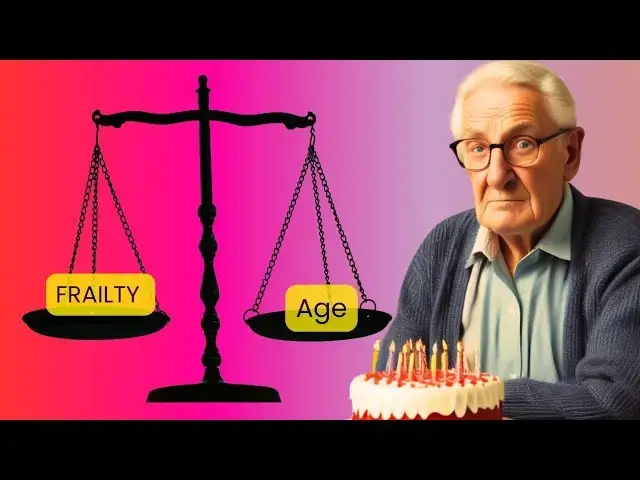0:05
hi this is Dr Arnaki I'm a geriatrician
0:08
oncologist with 12 years of experience
0:10
of taking care of older adults with
0:12
cancer Just today some of my patients
0:16
who met mentioned that they're worried
0:18
that their doctors may treat or not
0:21
treat their cancers simply because of
0:23
their age I discussed with them that age
0:27
is an irrelevant number and instead
0:30
their frailty should be taken into
0:34
consideration They wonder what is
0:36
frailty and why it should substitute
0:39
age I discussed with them and I'm going
0:41
to discuss it with you 10 reasons that
0:44
frailty is much better than your age in
0:50
healthcare So hope you enjoy this video
0:54
Please do not forget to like subscribe
0:57
to this channel and leave a comment
1:00
below The goal is to provide global
1:04
geriatric education for a global aging
1:10
you Over the course of past 12 years I
1:13
have seen many older patients who were
1:15
frustrated about why the doctors offered
1:19
or did not offer a treatment simply
1:21
based on their age I agree with the
1:24
patience I think it's time to move
1:26
beyond age and replace age with frailty
1:29
In this video I will share with you 10
1:31
reasons that frailty is much better than
1:33
your age Reason number one frailty is
1:37
not synonymous with age Chronological
1:40
age the number of years a person has
1:43
lived is a simple metric Biological age
1:46
on the other hand reflects the actual
1:49
physical state of the body Two
1:52
ADAs might present vastly different
1:56
profiles One could be actively engaged
1:58
in daily life while the other might
2:01
struggle with basic tasks Factors like
2:04
genetics lifestyle and past illnesses
2:09
disparity Frailty assessments aim to
2:12
capture this biological
2:14
variability offering a more accurate
2:16
picture of an individual's health
2:19
Reason number two frailty predicts
2:24
outcomes Studies consistently show that
2:27
frailty is a stronger predictor of
2:29
negative health outcomes than age Frail
2:32
individuals are more susceptible to
2:34
falls due to muscle weakness and balance
2:37
problems They are also more likely to
2:39
require hospitalization for acute
2:42
illnesses and experience prolonged
2:44
recovery periods Frailty is also a
2:48
strong indicator of increased disability
2:50
limiting their ability to perform daily
2:52
activities and higher mortality rates
2:57
three frailty captures physiological
3:00
reserve Physiological reserve refers to
3:03
body's ability to withstand
3:06
stress Age alone does not tell us how
3:09
well a person can cope with illness
3:12
surgery or other stressors
3:14
Frailty assessments evaluate this
3:17
reserve by looking at factors like
3:19
muscle strength gate speed and overall
3:22
physical function This information is
3:25
crucial for medical decisionm as it
3:28
helps health care professionals
3:29
anticipate how a patient might respond
3:32
to the treatment Reason number four
3:35
frailty is a dynamic process Unlike age
3:39
which is a fixed number frailty is a
3:42
dynamic state that can change over time
3:45
Lifestyle interventions such as regular
3:48
exercise a balanced diet and social
3:51
engagement can improve frailty
3:54
status Conversely inactivity poor
3:58
nutrition and chronic illnesses can
4:00
accelerate frailty progression This
4:03
dynamic nature allows for a proactive
4:08
Number five frailty informs personalized
4:12
care A one-sizefitit all approach to
4:14
health care is often inadequate for
4:16
older adults Frailty assessment provide
4:20
a detailed understanding of an
4:21
individual's specific needs and
4:25
vulnerabilities This allows health care
4:27
professionals to tailor treatments
4:30
medications and rehabilitation programs
4:33
to optimize outcomes and minimize risks
4:38
Reason number six frailty highlights
4:41
vulnerability Frail individuals are at
4:44
in increased risk for complications from
4:46
medical procedures and
4:48
illnesses For example they may have
4:51
difficulty recovering from surgery or
4:54
may be more susceptible to
4:56
infections Identifying frailty allows
4:59
healthc care providers to take extra
5:02
precautions and implement preventive
5:05
strategies Reason number seven frailty
5:10
factors Frailty is not solely a physical
5:13
phenomena It encompasses physical
5:17
psychological and social factors Factors
5:20
like muscle weakness cognitive decline
5:24
depression and social isolation can all
5:26
contribute to frailty
5:29
Comprehensive frailty assessment
5:31
consider these multiple dimensions
5:33
providing a holistic view of an
5:37
health Reason number eight frailty
5:40
promotes preventative care Early
5:44
identification of frailty allows for
5:46
proactive interventions to prevent
5:50
programs focused on exercise nutrition
5:54
social engagement can help maintain
5:56
physical function and cognitive health
5:59
This approach helps to maintain
6:01
independence and delay the onset of
6:04
disabilities Reason number nine frailty
6:08
improves quality of life By addressing
6:10
frailty we can help older adults
6:13
maintain their independence mobility and
6:15
cognitive function This translate to a
6:18
better quality of life allowing them to
6:20
participate in activities they enjoy and
6:23
maintain social connections Maintaining
6:26
independence and social connections are
6:28
very important for mental health And
6:31
finally reason number 10 frailty
6:34
enhances decision making When deciding
6:36
on treatment options frailty assessment
6:39
provides more pertinent information than
6:41
age alone For example a frail individual
6:45
may be at higher risk for complication
6:47
from surgery even if they are relatively
6:50
young This information helps health care
6:52
professionals weigh the risk and benefit
6:54
of different treatments and make


